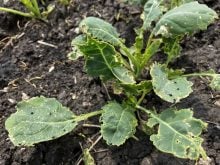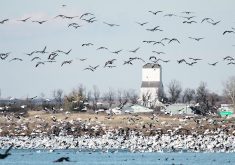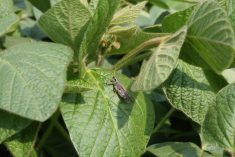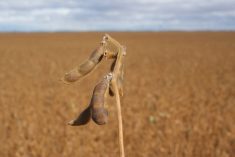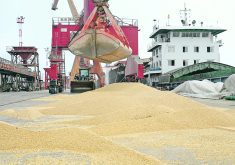Buyers of western Canadian soybeans are worried about protein.
A few buyers have expressed concerns about beans from Manitoba and Saskatchewan because protein levels in shipments have been below acceptable levels.
Francois Labelle, Manitoba Pulse & Soybean Growers Association executive director, said the protein issue has come up at industry meetings this winter.
“It’s just starting to be talked about,” he said from his office in Carman, Man. “Some of the buyers overseas have commented on (protein).”
Soybeans grown in Manitoba typically have protein levels of 32 to 34 percent compared to 35 to 36 percent for beans from places like Iowa, said Dale Hyde of Delmar Commodities, a company that buys beans and operates a soy crushing plant near Roland, Man.
Read Also

Farming Smarter receives financial boost from Alberta government for potato research
Farming Smarter near Lethbridge got a boost to its research equipment, thanks to the Alberta government’s increase in funding for research associations.
Manitoba and Saskatchewan soybeans have less protein because of cooler weather and varieties of beans grown on the Prairies.
“It’s just a reality that shorter days to maturity soybeans will produce lower protein levels,” Hyde said. “As you reduce the days to maturing on a soybean, you will have protein drag go along with that…. What is protein drag? I would say it’s two percent.”
Two percent doesn’t sound like much, but crushing plants need beans with a minimum amount of protein so that soybean meal satisfies a feed standard.
When Manitoba only had 500,000 acres of soybeans, the lower protein soy could be blended in with other beans. But now that acreage is approaching two million in Manitoba and Saskatchewan, the lower protein levels have become more noticeable.
Labelle said Manitoba isn’t the only soy-growing region with this challenge.
“I know this has been discussed in North Dakota. It’s been discussed in Iowa,” he said.
“Some of the crushers are starting to get concerned about lower protein down there…. It’s not just Manitoba.”
Besides the shorter growing season, part of the problem is that plant breeders have focused primarily on yield.
When yields go up, protein content typically goes down. Labelle said plant breeders can develop soybeans with higher amounts of protein, which are suitable for western Canadian conditions.
That may be true, but soybeans with more protein will likely have lower yields.
“It’s definitely a solvable problem,” said Elroy Cober, an Agriculture Canada soybean breeder in Ontario. “The question is can you afford to solve the problem? How much of a yield trade-off is there to raise the protein?”
Buyers may be raising red flags, but Manitoba soybean growers don’t need to panic, Hyde said.
However, they may need to accept slightly lower prices for their soybean, compared to beans from warmer regions.
“I don’t think it’s a real big deal,” he said. “It just has to be assumed that when we export it we may have a what I’ll call a basis discount at the port position.”
So, a soybean grower in Brandon might receive less for his beans than a producer in Watertown, South Dakota.
How much less is for the buyer to decide.
Contact robert.arnason@producer.com






